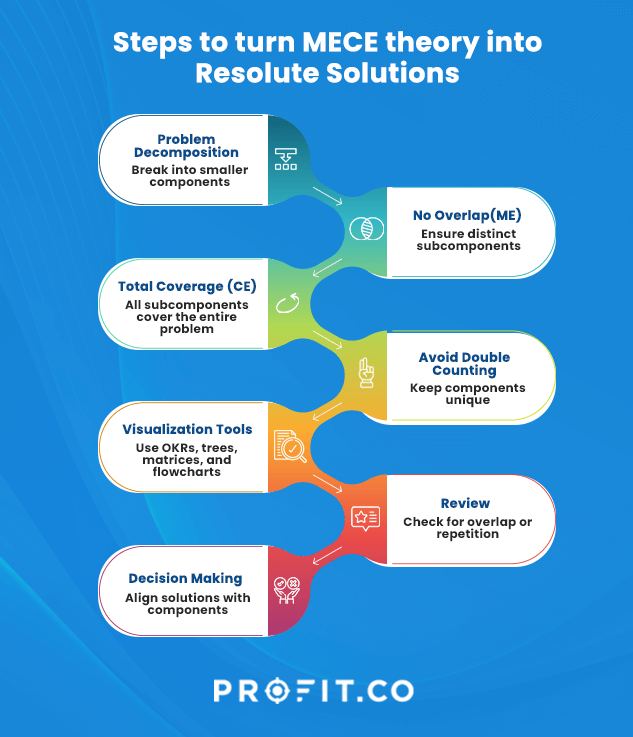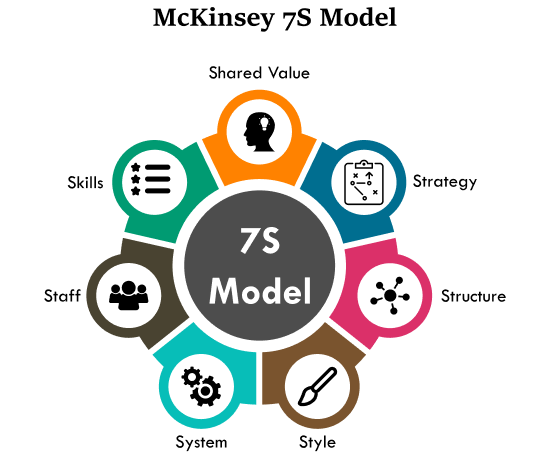Introduction
Sometimes problem-solving in business can make you feel like trying to piece together a jigsaw puzzle without a guiding picture. Yet, imagine if there was a systematic approach to decluttering this chaos, ensuring no piece is overlooked or doubly counted. You can achieve such perfection with the MECE framework—a principle from the elite corridors of management consulting, popularized by McKinsey.
MECE, which stands for “Mutually Exclusive, Collectively Exhaustive,” is a disciplined method to ensure clarity and completeness in any analytical effort. This elegant and intuitive methodology breaks down problems and organizes information in a way that ensures a comprehensive view without overlap or redundancy. MECE and OKRs (Objectives and Key Results) are both concepts used in strategy and planning, and while they originate from different contexts, they can complement each other effectively when applied together. Let’s pitch into the exciting union of these two and discover how they can transform the way we tackle problems and set targets.
MECE: The Foundation of Clear Thinking
In the expansive world of business strategy and problem-solving, clarity of thought is crucial. One principle stands out in its ability to sharpen the mind and create focus. The MECE framework is a powerful tool in the world of management consulting and analytical problem-solving.
Let’s break down what it stands for and why it’s valuable :
What is the MECE Framework?
The MECE framework stands for Mutually Exclusive, Collectively Exhaustive. It is a principle often used in management consulting, strategy formulation, and problem-solving to organize information or data. The aim of MECE is to ensure comprehensive coverage of any given topic or problem, without overlap or omission.
Mutually exclusive
This means that the categories or sets you’re working with don’t overlap. Each item or piece of data belongs to one and only one category. By ensuring no overlaps, you eliminate the risk of double-counting or overlooking information
Collectively exhaustive
This ensures that all possible items or pieces of data are considered. Together, the categories or sets cover all potential options or scenarios. It means you’ve captured every aspect of the problem or situation, leaving no stone unturned.
Ready to start your OKR journey for FREE?
Why MECE Stands Out in Structured Thinking?
With the MECE framework, your strategy can stand out as a holistic approach, ensuring conflict resolution, clarity, thoroughness, and structured thinking. Here are some analytical points that highlight the advantages of the MECE framework:
Structured thinking
MECE promotes an organized approach to dissecting problems or situations. By categorizing information into distinct, non-overlapping groups, it encourages systematic thinking and step-by-step problem-solving
Eliminates redundancies
Since the categories or segments in a MECE framework don’t overlap (they are mutually exclusive), there’s no risk of double-counting or repeated efforts. This streamlining enhances efficiency.
Comprehensive analysis
The “collectively exhaustive” aspect ensures that every possible scenario or piece of data is considered. This thoroughness ensures a holistic view of the problem and reduces the risk of overlooking critical information.
Enhanced communication
MECE’s clear and organized structure allows for better communication of ideas, findings, and solutions. Whether you’re presenting to stakeholders, teammates, or clients, a MECE-structured analysis can be easier to understand and follow.
Facilitates collaboration
By breaking down problems into mutually exclusive categories, teams can assign specific components to different members, ensuring focused efforts without overlap.
Versatility
While the MECE framework originates from management consulting, its principles are versatile and can be applied across various industries and fields, from research to project management and beyond.
Supports quantitative analyses
When problems are broken down using MECE, assigning metrics and KPIs to each segment becomes easier. This structure supports data-driven decision-making and more quantifiable results.
Facilitates continuous improvement
By ensuring all elements of a problem or process are considered, teams can continuously review and improve each segment, leading to iterative and incremental enhancements.

How MECE Framework Breaks Down Problems into Workable Solutions?
Applying the MECE framework ensures that you analyze a situation or problem in a comprehensive and structured way. For instance, when dissecting a business issue, one might categorize the challenges faced by a company into operational, financial, technological, and human resources. These categories do not overlap (mutually exclusive), yet they cover the entire spectrum of possible challenges (collectively exhaustive). This systematic approach ensures that solutions and strategies are holistic, reducing the risk of overlooking potential issues or duplicative efforts.
Problem decomposition
Break down the main problem or issue into smaller, more manageable components.
Ensure no overlap
Make certain that each of these subcomponents is distinct, with no overlap (Mutually Exclusive).
Guarantee total coverage
Ensure that, when considered in unison, the subcomponents account for every aspect of the problem (Collectively Exhaustive).
Avoid double counting
By keeping components mutually exclusive, prevent the repetition or double counting of elements.
Visualization tools
Use tools like OKRs, decision trees, matrices, or flowcharts to help in structuring problems based on the MECE principle.
Iterative review
Periodically review the components to ensure that they remain both mutually exclusive and collectively exhaustive as more information is gathered.
Decision making
Use the structured breakdown to make more informed decisions, as potential solutions can be aligned with the individual components.
How McKinsey Used the MECE Framework as a Problem-Solving Strategy?
McKinsey & Company, one of the world’s most renowned management consulting firms, has been instrumental in popularizing the MECE principle. McKinsey consultants employ the MECE principle throughout various stages of their client engagements, and it’s deeply ingrained in their problem-solving methodology. The other consultants like McKinsey use the MECE principle to ensure that their analyses are comprehensive and non-overlapping. This is essential in problem-solving because overlooking a category or double-counting can lead to incorrect conclusions.
For instance, if a company is trying to understand why its profits are declining, a MECE approach might divide the problem into revenue issues and cost issues, and then further break down those categories into more detailed sub-categories. This ensures that every possible cause of the profit decline is considered
Here’s how McKinsey has historically used the MECE principle
Issue Trees
McKinsey consultants often use issue trees (or logic trees) to break down a problem systematically. These trees decompose problems into sub-issues, ensuring that the sub-issues are MECE. This visual representation helps both the consultants and clients to understand the breadth and depth of a problem and the structured approach to addressing it.

Framework development
McKinsey is famous for its frameworks (e.g., the 7S Framework). The MECE principle is applied in the creation of these tools to ensure they are comprehensive and non-overlapping, providing clear avenues for analysis and strategy development.

Training
McKinsey integrates the MECE principle into its training programs for new consultants. This foundational tool becomes a part of the consultant’s thinking and problem-solving toolkit from the early days of their career.
While the MECE principle is a staple in McKinsey’s approach, it’s essential to understand that it is just one tool among many. Successful problem-solving requires not just structured thinking but also creativity, intuition, industry knowledge, and strong client relationships. However, MECE provides a foundational framework upon which these other skills can be effectively layered.
The Synergy of MECE & OKRs
OKR stands for “Objectives and Key Results.” It is a goal-setting framework that helps organizations set, communicate, and track their goals. Originating from Intel and popularized by companies like Google, OKRs have become a favored tool for many businesses worldwide to drive focus, alignment, and engagement. The power of OKRs lies in their simplicity, transparency, and alignment, ensuring everyone in the organization understands the bigger picture and how their efforts contribute to overarching goals.
When combined, MECE and OKRs can supercharge your strategic planning and execution.
Clarity in problem-solving
Use MECE to break down complex problems into distinct categories. This simplification ensures you’re not overlooking any aspect and not double-counting any factors.
Focused goal setting
Once problems are broken down, set OKRs for each category. This ensures that your approach to solving problems is goal-oriented and measurable.
Streamlined communication
The clarity afforded by MECE and the specificity of OKRs ensures that teams aren’t lost in the noise. Everyone knows what they’re working towards and how their contribution aligns with broader objectives.
Monitor & iterate
With clear KR metrics, you can track progress and recalibrate your strategies if something isn’t working. This agile approach is invaluable in today’s business and technology environment, so make the maximum use of it.
MECE & OKRs when Put into Practice
Whether you’re a manager, a CEO, or just someone trying to get a better grip on their personal goals, two tools can come to your aid: the MECE Framework and OKRs. Let’s say that a tech company aims to improve its revenue streams and operational efficiency. You create an OKR to set your goal into achievable action. This objective states a problem that needs a solution
Objective
Increase overall company revenue and operational efficiency.
Keyresults
KR1: Product Revenue: Increase software product sales by 20%.
KR2: Service Contracts: Secure 10 new long-term contracts for IT services.
KR3: Licensing: Increase licensing revenue by 15%.
KR4: Operational Efficiency: Reduce operational costs by 10%.
KR5: Customer Retention: Increase customer retention rate by 5%
Using Keyresults to Apply MECE Framework
Now when you want to strategize your business goals using the MECE framework, try using the keyresults to break down the targets. To ensure a comprehensive and non-overlapping approach to achieving the objective, you frame the key results in a MECE’d way. Here you can see that the key results don’t overlap. Each item or category is distinct and separate from the others but they all together can solve one problem which is to Increase overall company revenue and operational efficiency. These Key Results collectively cover all significant areas of the company’s revenue streams and operational domains. Together, they ensure that the company addresses all avenues for improvement.
Whether you’re a budding entrepreneur or someone aiming for personal growth, merging the MECE framework with OKRs can be a game-changer.
FAQs on MECE and OKRs
1. What is the MECE and OKR union?
The union of MECE and OKR combines the principles of the Mutually Exclusive, Collectively Exhaustive (MECE) framework with the Objectives and Key Results (OKR) goal-setting methodology. It ensures a structured and comprehensive approach to setting and achieving organizational goals without overlaps or gaps.
2. How does MECE complement the OKR framework?
MECE ensures that the Key Results set under an Objective are non-overlapping (Mutually Exclusive) and cover all areas required to achieve the Objective (Collectively Exhaustive). This prevents redundancy and guarantees comprehensive coverage.
3. Why should an organization consider integrating MECE with OKR?
Integrating MECE with OKR can help organizations create a more streamlined, focused, and efficient goal-setting process. It ensures that all essential areas are addressed while preventing efforts from being duplicated.
4. Can the MECE and OKR union be used for any type of goal or objective?
Yes, while the union is highly adaptable and can be used for various objectives, its efficiency depends on how well the goals are broken down and how effectively they are communicated to the teams.
5. What are the potential challenges when combining MECE with OKRs?
One challenge might be ensuring that the Key Results truly are MECE. There’s a risk of over-segmentation or overlooking some areas. It requires meticulous planning and review to get it right.
6.Can an organization use MECE without OKR, or vice versa?
Absolutely. MECE is a principle of categorization and can be used in various scenarios, not just goal-setting. Likewise, OKRs can be used without the MECE framework, though combining them can enhance clarity and comprehensiveness.
7. Does the MECE and OKR union require specific tools or software?
No, while there are numerous tools available to manage OKRs, the integration of MECE principles is more about the approach and methodology than the tools themselves.
8. How can teams be trained on the MECE and OKR union?
Regular workshops, seminars, and hands-on training sessions can introduce teams to both concepts. It’s essential to provide real-life examples and case studies to make the union more relatable and understandable.
Final Thoughts
While MECE provides a structured way of thinking and ensuring clarity, OKRs provide a framework for setting, tracking, and achieving goals based on that thinking. Combining both ensures clarity, focus, and efficient execution in strategic planning and operation. As we’ve journeyed through the union of MECE and OKRs, it’s clear that charting a course in strategic planning and execution is no minor feat. But with MECE’s precision and OKR’s focus, we’ve got a solid strategic plan in hand. Remember, every grand execution begins with a single strategic plan and a solid determination. Forge your ambitions with these tools, and watch as your goal expands. Set up confidently, and may your organizational endeavors be favorable!
